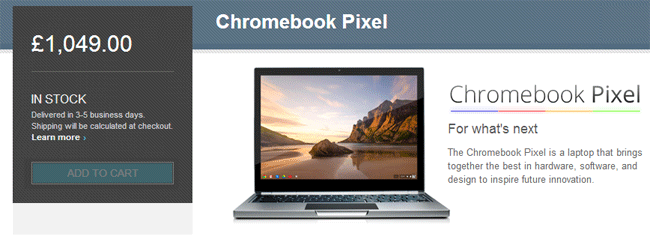The first “brand new newspaper for 30 years” just launched: ‘The New Day’. The pitch is nice: A small team of 25 staff. Gender neutral, politically neutral, & focused on positivity. It sounds like a very light, non-business version of the FT. It was free for the first day, will be 25p for the first 2 weeks, and then 50p from there onward. Across the course of a year, that’s £182.50 at full price. As context, the UK TV license is currently £145.50.
The paper has been launched by Trinity Mirror who, including The Mirror, own 260 newspaper titles, plus their own Email Service Provider (communicator), and their own Digital Agency (rippleffect). It is 2016, and every other newspaper in the land has been talking about ‘Digital First’ for the last five years. Newspapers have finally caught up on the opportunities around email. And ‘social’ is one of the biggest channels around for newspapers.
So bearing all this in mind, it is slightly strange that The New Day has no website, is not collecting email addresses, and seems slightly slow on social media. Here are some notes on the launch:
1. No website.
I’d said that The New Day has no website. They also say in interviews that they have no website. But actually this isn’t quite true. They do have a website, but it’s tough to find: It doesn’t rank in Google for their name. During the crucial launch period, they were not buying paid ads on the name. Etc. Here’s what you find if you search for it on Google:
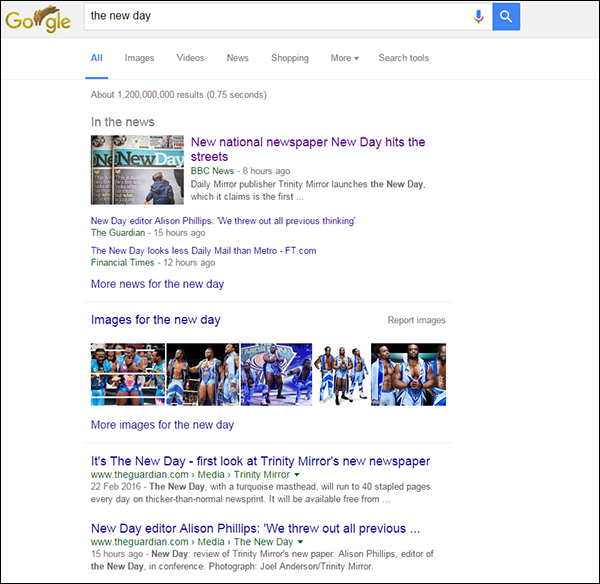
Note their sister publications don’t even rank there. Ie: The FT & The Guardian have made more money online from the New Day than they have themselves.
24 hours after their launch, someone eventually saw sense & launched a Google Ad for the brand name, but it’s a shame to have missed the ‘big interest’ launch period:
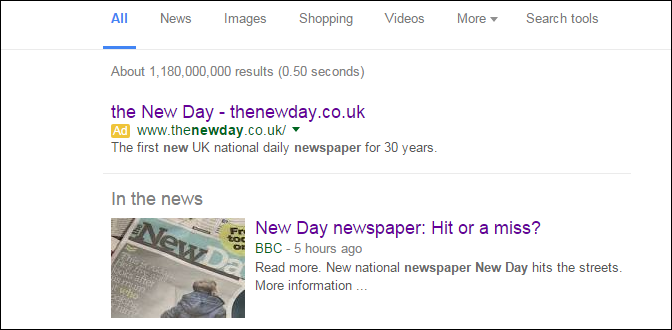
2. When you do find the website…
The team themselves say that the paper will have no website. Here’s a quote from the BBC news article covering its launch:

“It will not have a website” it says. But of course – there is a site – it’s just extremely sparse:
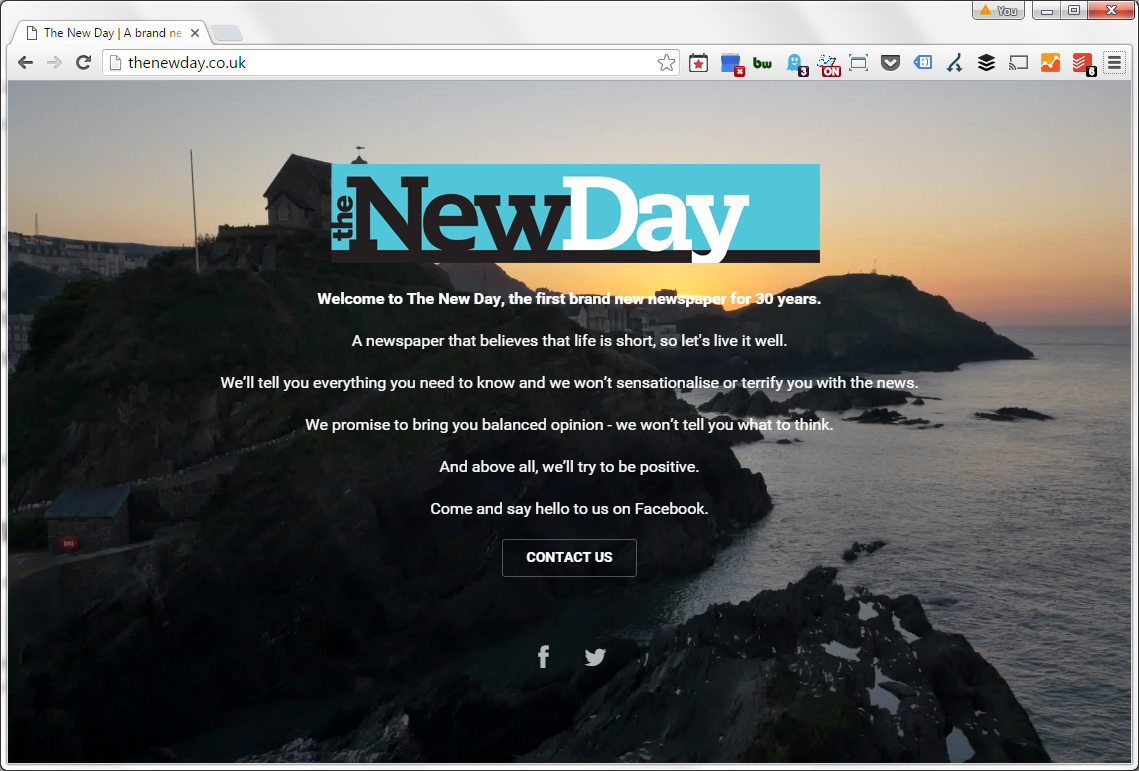
It’s hosted on the web hosting provider TSOhost. That’s not bad, but it’s not great. It’s the internet service provider I use to host ‘non-critical’ websites (for example this one), whereas I opt to use other more reliable/faster hosts for those where it’s critical they stay available.
The site has obviously been hastily put together:
- The background is a looping Youtube video, uploaded on the 26th February with the title “Sun Illfracombe” (sic);
- The code hides the text “Welcome to the New Day, the first new newspaper for 30 years.” which has been replaced with the slightly more specific “Welcome to The New Day, the first brand new newspaper for 30 years.”
- The title tag is the slightly clumsily worded “A brand new UK National Paper for women and men. Gives context, background and points of view rather than just reporting of what people probably have already heard”
You could forgive them the hurry, and for not having a fully finished website just yet. The domain names were only registered a few weeks ago and, though they say they’ve been working on it since last summer, most of the staff only joined in January or February this year according to LinkedIn. But they aren’t saying “we don’t have a website yet”, they’re saying this is the strategy: “we won’t have a website”.
This makes little sense. An app may make sense. A site simply collating their tweets may even make sense. A big box saying ‘Sign Up For Email Updates’ may make sense. If their content was utterly, radically different to most content from other online sources it may make sense. It might even make sense if they had a message saying “You won’t find our content online: We’re an offline only publication. Buy us today”, along with the latest front cover image may make sense. But a non-site that they’ve deliberately created simply as a holding page does not make sense.
A commenter on Facebook summed up the puzzling nature of this here:

3. Twitter
Here’s the tweet that launched the first ever cover of the newspaper into the world:
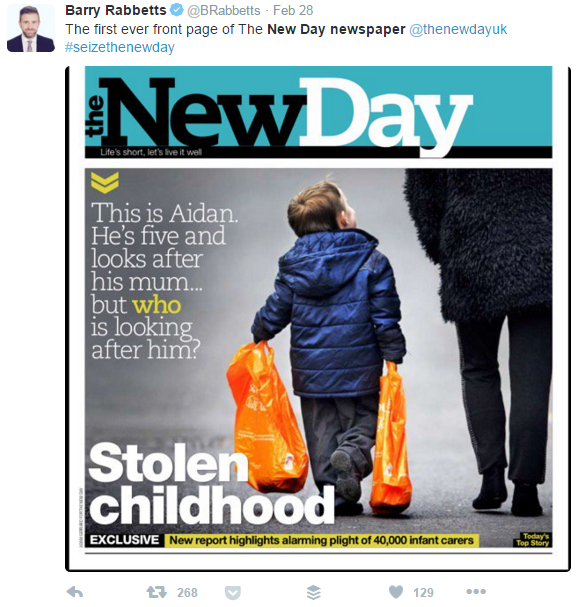
268 retweets. Not bad, right? Only… that’s not the main Twitter account that tweeted it: it’s a member of staff (actually the Exec Editor). It’s not a big deal, but doing this slows the likelihood of growing followers for the brand, in favour of growing them (to a much lesser extent) for the member of staff whose tweet gets picked up first. I assumed they’d fix this on day two, but exactly the same happened again.
4. Facebook & other Social Media
The Facebook account is a little better. The purpose of it seems to be to gather feedback from readers. That makes some sense: Without comments, it’s tough to understand what is working & what is not (the Daily Mail, for example, is on track to hit 2 billion up/down votes on comments this year, which gives them a huge amount of insight into which articles drive engagement, and which readers are engaged). They also seem to be actively reading & responding to some comments, albeit some may be a little over earnest:
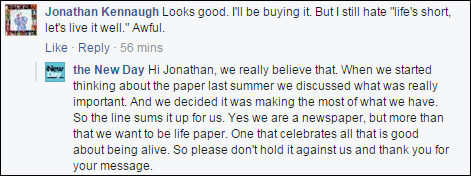
Outside of Facebook & Twitter, there is no social footprint. Because there is no website, there are no ‘share on whatsapp’ or ‘share by email’ buttons. Unlike most newspapers, where every view of an article is also an opportunity for it to be shared, to bring extra traffic, and to expand audience, the New Day’s content exists in static paper form only. In an age where “How to boil an egg” by Heston Blumenthal can get more than 35,000 shares for The Guardian, that is quite a disadvantage.
5. Email
As touched on, ’email’ has finally caught up as one of the focus channels for many newspapers. Email allows a paper to form an ‘ongoing dialogue’ (or really more of a monologue) with readers, without having to rely on them remembering to visit the site, or open the app.
Generally, many newspaper sites interact with audience through the following layers, from ‘shallowest’ users through to ‘deepest’:
- Social media reader.
- Social follower.
- Site user.
- Commenter/participant.
- Email subscriber/site member.
- Paying customer.
In the case of the New Day, the first couple of layers exist (as bolded), the last layer exists (newspaper purchasers), but the layers in the middle do not. Without the expense & time of building a site, ’email subscriber’ would be the easiest way for them to bridge the odd gap between their social accounts & the paper, and to communicate with readers without simply waiting for them to turn up at the newsagent & pick up a copy. As with the ‘no website’ status being odd, this is quite strange for a group that owns an Email Service Provider.
6. Data.
Alongside the above, having some sort of email presence would also allow the New Day team to mitigate one of the biggest downsides of their ‘no website’ strategy: They have very, very little opportunity to gather data on their audience.
In a strange way I suppose that may help their ad targets: There’s far less accountability to advertisers than online.
But from a ‘success’ point of view, whereas all of their competitors can see which journalists are most read, which articles are most popular, which are most shared, who their regular readers are, which ads are engaging, the demographically categorised popularity of every aspect of their journalism, the New Day is reliant on guesswork, educated guesses, and focus groups. This is not the end of the world: It’s how many papers operated 20 years ago. Perhaps they can accurately guess the exact content that will take them to the 200,000 daily readership target they’ve set, but it would definitely be easier if they had any sort of data to judge what is/is not working.
Summary
The New Day is an interesting project. A tiny team compared to many newspapers, a different approach in terms of gender/politics to many. And the odd idea of going ‘print first’ in a world where almost every other newspaper went ‘digital first’ many years ago.
The nearest equivalent in the UK in recent years was the “i” newspaper. A cut-down version of The Independent, which did not have its own website specifically, though it did benefit from the brand recognition of its parent the Independent, along with the Independent’s website, and the i100 website that almost shared its name.
Perhaps The New Day seeks to own the gap left by the soon-to-be-discontinued Independent newspaper. They have the similar positives of an experienced staff & a wealthy owner (Trinity Mirror), but the equally enormous, in my opinion, downsides of having zero online presence, zero ability for readers to share popular content among friends & family, and zero data to understand where they are performing well, and where they could improve.
Good luck to them. I look forward to seeing how it progresses.
